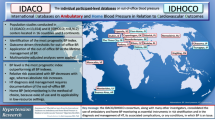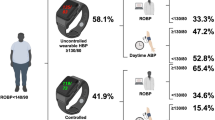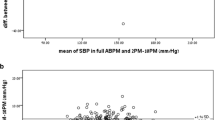Abstract
Ambulatory blood pressure monitoring (ABPM) is commonly used in clinical trials. Yet, its ability to detect blood pressure (BP) change in comparison to multiple office-based measurements has received limited attention. We recorded ambulatory and five daily pairs of random zero (RZ) BPs pre- and post-intervention on 321 adult participants in the multicentre Dietary Approaches to Stop Hypertension trial. Treatment effect estimates measured by ambulatory monitoring were similar to those measured by RZ and did not differ significantly for waking vs 24-h ambulatory measurements. For systolic BP, the standard deviations of change in mean 24-h ambulatory BP (8.0 mmHg among hypertensives and 6.0 mmHg among nonhypertensives) were comparable to or lower than the corresponding standard deviations of change in RZ-BP based on five daily readings (8.9 and 5.9 mmHg). The standard deviations of change for mean waking ambulatory BP (8.7 and 6.7 mmHg) were comparable to those obtained using three to four daily RZ readings. Results for diastolic BP were qualitatively similar. Ambulatory monitoring was more efficient (ie, a smaller sample size could detect a given BP change) than three to four sets of daily RZ readings and required fewer clinic visits. The average of 33 ambulatory BP readings during the waking hours had an efficiency comparable to that from the mean of four daily pairs of RZ-BPs. Participants readily accepted the ABPM devices, and their use requires less staff training. ABPM provides a useful alternative to RZ-BP measurements in clinical trials.
This is a preview of subscription content, access via your institution
Access options
Subscribe to this journal
Receive 12 digital issues and online access to articles
$119.00 per year
only $9.92 per issue
Buy this article
- Purchase on Springer Link
- Instant access to full article PDF
Prices may be subject to local taxes which are calculated during checkout
Similar content being viewed by others
References
Mancia G et al. Ambulatory blood pressure monitoring in the design of studies on antihypertensive drug efficacy. Am J Hypertens 1993; 6(Part 2): S233–S235.
Coats AJ . Benefits of ambulatory blood pressure monitoring in the design of antihypertensive drug trials. Blood Press Monit 1996; 1: 157–160.
Staessen JA et al. Ambulatory blood pressure monitoring in clinical trials. Blood Press Monit 1996; 1: 223–225.
Waeber B, Brunner HR . Clinical value of ambulatory blood pressure monitoring in the assessment of antihypertensive therapy. Blood Press Monit 1999; 4: 263–266.
National High Blood Pressure Education Program Working Group. Report on ambulatory blood pressure monitoring. Arch Intern Med 1990; 150: 2270–2280.
Appel LJ, Stason WB . Ambulatory blood pressure monitoring and blood pressure self-measurement in the diagnosis and management of hypertension. Ann Intern Med 1993; 118: 867–882.
Waeber B et al. Are some hypertensive patients overtreated? A prospective study of ambulatory blood pressure recording. Lancet 1987; 2: 732–734.
Weber MA, Cheung DG, Graettinger WF, Lipson JL . Characterization of antihypertensive therapy by whole-day blood pressure monitoring. JAMA 1988; 259: 3281–3285.
Cheung DG, Gasster JL, Weber MA . Assessing duration of antihypertensive effects with whole-day blood pressure monitoring. Arch Intern Med 1989; 149: 2021–2025.
Trazzi S et al. Reproducibility of non-invasive and intra-arterial blood pressure monitoring: implications for studies on antihypertensive treatment. J Hypertens 1991; 9: 115–119.
Conway J, Coats A . Value of ambulatory blood pressure monitoring in clinical pharmacology. J Hypertens 1989; 7(Suppl): S29–S32.
Appel LJ, Marwaha S, Whelton PK, Patel M . The impact of automated blood pressure devices on the efficiency of clinical trials. Control Clin Trials 1992; 13: 240–247.
Conway J et al. The use of ambulatory blood pressure monitoring to improve the accuracy and reduce the numbers of subjects in clinical trials of antihypertensive agents. J Hypertens 1988; 6: 111–116.
Prisant LM et al. Repeatability of automated ambulatory blood pressure measurements. J Fam Pract 1992; 34: 569–574.
Mancia G et al. Limited reproducibility of hourly blood pressure values obtained by ambulatory blood pressure monitoring: implications for studies on antihypertensive drugs. J Hypertens 1992; 10: 1531–1535.
Silagy CA et al. Components of blood pressure variability in the elderly and effects on sample size calculations for clinical trials. Am J Hypertens 1992; 5: 449–458.
Staessen JA et al. Clinical trials with ambulatory blood pressure monitoring: fewer patients needed? Syst-Eur Investigators. Lancet 1994; 344: 1552–1556.
Mancia G, Lanfranchi A, Turri C, Grassi G . Can good surrogate end-points predict the prognosis of hypertensive patients? J Hypertens 1998; 16(Suppl 5): S3–S7.
Mancia G et al. Ambulatory blood pressure is superior to clinic blood pressure in predicting treatment-induced regression of left ventricular hypertrophy. Circulation 1997; 95: 1464–1470.
Fotherby MD, Potter JF . Potassium supplementation reduces clinic and ambulatory blood pressure in elderly hypertensive patients. J Hypertens 1992; 10: 1403–1408.
Fotherby MD, Potter JF . Effects of moderate sodium restriction on clinic and twenty-four-hour ambulatory blood pressure in elderly hypertensive subjects. J Hypertens 1993; 11: 657–663.
Moore TJ, Malarick C, Olmedo A, Klein RC . Salt restriction lowers resting blood pressure but not 24-h ambulatory blood pressure. Am J Hypertens 1991; 4(Part 1): 410–415.
Moore TJ et al. Effect of dietary patterns on ambulatory blood pressure: results from the Dietary Approaches to Stop Hypertension (DASH) Trial. DASH Collaborative Research Group. Hypertension 1999; 34: 472–477.
Sacks FM et al. Rationale and design of the Dietary Approaches to Stop Hypertension trial (DASH). A multicenter controlled-feeding study of dietary patterns to lower blood pressure. Ann Epidemiol 1995; 5: 108–118.
Appel LJ et al. A clinical trial of the effects of dietary patterns on blood pressure. DASH Collaborative Research Group. N Engl J Med 1997; 336: 1117–1124.
Karanja NM et al. Descriptive characteristics of the dietary patterns used in the Dietary Approaches to Stop Hypertension Trial. DASH Collaborative Research Group. J Am Diet Assoc 1999; 99(Suppl): S19–S27.
Hebert PR et al. Design of a multicenter trial to evaluate long-term life-style intervention in adults with high-normal blood pressure levels. Trials of Hypertension Prevention (phase II). Trials of Hypertension Prevention (TOHP) Collaborative Research Group. Ann Epidemiol 1995; 5: 130–139.
Jones DW, Appel LJ, Sheps SG, Roccella EJ . Measuring blood pressure accurately: new and persistent challenges. JAMA 2003; 289: 1027–1030.
Rosner B, Polk BF . Predictive values of routine blood pressure measurements in screening for hypertension. Am J Epidemiol 1983; 117: 429–442.
Sheps SG, Bailey KR, Zchariah PK . Short-term (six hour), ambulatory blood pressure monitoring. J Hum Hypertens 1994; 8: 873–878.
Eva's paper on measurement of sodium responders.
Clement DL et al. Prognostic value of ambulatory blood-pressure recordings in patients with treated hypertension. N Engl J Med 2003; 348: 2407–2415.
Kario K et al. Morning surge in blood pressure as a predictor of silent and clinical cerebrovascular disease in elderly hypertensives: a prospective study. Circulation 2003; 107: 1401–1406.
Acknowledgements
We wish to thank the DASH participants for their contribution to this study, and the DASH staff and the members of the DASH Data Safety and Monitoring Board for all their hard work on behalf of the study. This work was supported by cooperative agreements #HL50968, HL50972, HL50977, HL50981, HL50982, HL02642, RR02635, and RR00722 from the National Heart, Lung, and Blood Institute, the Office of Research on Minority Health, and the National Center for Research Resources of the National Institutes of Health.
Author information
Authors and Affiliations
Consortia
Corresponding author
Appendix A
Appendix A
This appendix describes the procedure used to compare the various intervention effect size estimates in Table 1.
Let OM1 and OM2 be two correlated outcome measures (eg, RZ-BP and mean 24-h ambulatory blood pressure), and assume interest is focused on the effect of the DASH dietary pattern. For OM1, the effect of the DASH diet, net of control, can be expressed as ( ), where
), where  is the observed mean difference in OM1 from baseline to end-of-study for participants eating the DASH diet, and
is the observed mean difference in OM1 from baseline to end-of-study for participants eating the DASH diet, and  is the comparable difference for those eating the control diet. In order to test whether the DASH diet effects measured by OM1 and OM2 are equivalent, we compute
is the comparable difference for those eating the control diet. In order to test whether the DASH diet effects measured by OM1 and OM2 are equivalent, we compute

which can be rewritten as

Once in this form, δ can be seen to be the simple difference in two means, X̄ and Ȳ, where X1, …, Xn1 and Y1, …, Yn2 are n1+n2 mutually independent individual paired differences defined by Xi=(ΔOM1DASH,i−ΔOM2DASH,i) and Yi=(ΔOM1cntl,i−ΔOM2cntl,i). If sx2 and sy2 are the estimated standard deviations of the X's and Y's, then

will have an approximate Student's t-distribution for sufficiently large n1 and n2, and can thus be used to test the null hypothesis that δ=0.
Rights and permissions
About this article
Cite this article
Vollmer, W., Appel, L., Svetkey, L. et al. Comparing office-based and ambulatory blood pressure monitoring in clinical trials. J Hum Hypertens 19, 77–82 (2005). https://doi.org/10.1038/sj.jhh.1001772
Received:
Revised:
Accepted:
Published:
Issue Date:
DOI: https://doi.org/10.1038/sj.jhh.1001772
Keywords
This article is cited by
-
Physical Activity In Renal Disease (PAIRED) and the effect on hypertension: study protocol for a randomized controlled trial
Trials (2019)
-
The cholinergic anti-inflammatory pathway in resistant hypertension treated with renal denervation
Molecular Medicine (2019)
-
Efficacy and safety of azilsartan medoxomil, an angiotensin receptor blocker, in Korean patients with essential hypertension
Clinical Hypertension (2018)
-
Identification of dietary patterns associated with blood pressure in a sample of overweight Australian adults
Journal of Human Hypertension (2016)
-
Pharmacologic Management of Pediatric Hypertension
Pediatric Drugs (2016)



